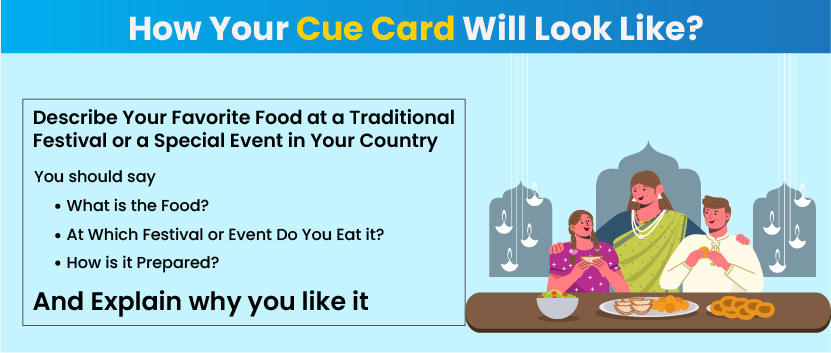Food plays an essential role in many cultures, especially during traditional festivals and special events. In the IELTS Speaking exam, you may be asked to describe your favourite food that is commonly served during a traditional festival or special event in your country. This is a great opportunity for you to talk about cultural traditions, the significance of food in celebrations, and why you enjoy it. In this blog, we will guide you through how to effectively answer this question in the IELTS exam, providing a clear structure, useful vocabulary, and sample answers to help you succeed.

Table of Contents
In IELTS cue cards, the test takers get a prompt that has questions. They have to speak on the topic and include the answers to those questions. After you get the cue card, you will have a minute to think about what you will be going to speak for the next 2 to 3 minutes. Thus, the IELTS speaking part 2 is also known as the IELTS cue card.
It can be that the topic you get are about your personal experiences or beliefs. A cue card's objective is to test your ability to think and articulate your ideas well.
Firstly, you will have to get acquainted with the pattern of the IELTS exam. This will help you prevent from making errors in IELTS speaking section. This is important to note that you will only get a minute to plan a good answer of 2 minutes! Thus, you have to be quick in thinking and think in the right direction. Moreover, you don’t have an option to get another cue card. Besides, you will also need to have good speaking skills apart from being fast. Thus, this blog covers the sample answers to the cue card topic, "Describe Your Favourite Food at a Traditional Festival or Special Event in Your Country"
Let's learn how your potential cue card on "Describe Your Favourite Food at a Traditional Festival or a Special Event in Your Country" will look. Refer to the image below.
Describe Your Favourite Food at a Traditional Festival or a Special Event in Your Country
Here is the first sample to help you understand how to answer “Describe Your Favourite Food at a Traditional Festival or a Special Event in Your Country” IELTS cue card.
India is a country where diversity has facilitated every other day to be a festival for either one group of people or the other. Moreover, co existing between so many cultures has brought two valuable things in my life: empathy and good food!
One of my favorite Indian traditional dishes is ‘kheer’ (rice pudding). This is a dessert that is prepared in many cultures which has core memories of my childhood attached to it.
Although this dish is prepared in countless households on different occasions in India, I got to taste it as a treat from my neighbour on the festival of Eid al Fitr. Moreover, in our culture, kheer is prepared with saffron and tapioca pearls.
This is an easy but delicious and appetizing dish. Moreover, I am aware that it has more than one way of making and can have several additional ingredients. Yet, my favorite is the one with rice, milk, cashews, almonds, and sugar with a hint of cardamom.
The texture of milk-soaked rice with nuts is very satisfying. Moreover, the taste is healthy and the best part is that we can add less sugar or another healthy sweetener. Also, it reminds me of my previous neighbour and one of my best childhood friend in colony.
Kheer has always been a symbol of affection and care towards people for me. Thus, I prefer to have this dessert on many special events.
Here is the second sample to help you understand how to answer “Describe Your Favourite Food at a Traditional Festival or a Special Event in Your Country” IELTS cue card.
I am very fond of laddoo, a famous Indian sweet, prepared on many occasions. It is round in shape and has sandy crumbs. The primary ingredients are chickpea flour, ghee, and sugar.
In Indian cuisine, laddoo is one of the best sweets prepared on various Indian festivals. Moreover, there are several variations of laddoo.
As I said, there are many variants of this traditional dish, each occasion calls for a different type of laddoo. Hence, Makar Sankranti or Kite flying festival calls for ‘til ke laddoo’ (Sesame Laddoos), and on Diwali, families prepare ‘motichoor ke laddoo’. However, my favorite are ‘besan ke laddoo’ (gram flour laddoo). These are prepared on the occasion of Ganesh Chaturthi in India.
The primary ingredients include gram flour, ghee, and sugar. this Indian dessert requires patience and practice to be perfectly round and tender. It is preferable to choose sugar powder instead of sugar crystals. We can start by heating a little ghee on a heavy bottom pan. Further, add a cup of gram flour and stir on low heat.
After 7 to 8 minutes, it starts to loosen up and forms a paste like starchy texture. Add the powdered sugar with cardamom powder for flavour and mix to make a dough. Carve out round balls from it and they are ready to eat.
I like it more than any other Indian dessert because the texture is very soft and it melts in the mouth as soon as one takes a bite. It is delightfully sweet and I have some of my core memories surrounding this dish.
Overall, it helps me connect to my rich cultural heritage and reminds me of my family.
Here is the third sample to help you understand how to answer “Describe Your Favourite Food at a Traditional Festival or a Special Event in Your Country” IELTS cue card.
My favorite traditional dish is samosa. It is perfect for every occasion as for many, it is a go to snack or a warm welcoming.
My all time favorite traditional dish is a samosa. I prefer savoury over sweet. Moreover, you can find a samosa anywhere very easily. Also, it is one of the most inexpensive Indian snacks.
The traditional dish that rules my diet plans on cheat days. They work as perfect snacks for visitors and are also famously craved on festivals like Makar Sankranti and Holi. Be it canteen or breakfast platter, samosas can make any gathering better.
Samosa is a triangular pastry with a mouth watering and savoury filling of mashed potatoes, Indian spices, and peas.
I prefer them mostly because they are very tasty and quite fulfilling. Moreover, they always remind of warm and lovely memories with family and friends.
Overall, their crispy pastry shell and soft and savoury filling makes it the perfect snack for those with an Indian palate.
| WORDS | MEANING |
|---|---|
| Diversity | The wide variety of something |
| Facilitated | To make something possible or easier |
| Existing | That is already there or being used; present |
| Valuable | Worth a lot of money or something very useful |
| Empathy | The ability to imagine how another person is feeling and so understand his or her mood |
| Core memories | A specific set of memories that hold a lot of emotional value. |
| Households | A family or a group of people living together. |
| Tapioca pearls | It is an edible translucent ball which is made from starch produced from cassava root. |
| Delicious | Having a very pleasant taste or smell |
| Appetizing | Something that looks or smells attractive and tasty that makes you feel hungry. |
| Ingredients | One of the items of food you need to make something to eat |
| Cardamom | Dried seeds of a specific plant belonging to South East Asia. It is used as a spice in cooking. |
| Soaked | extremely wet |
| Sweetener | A substance used instead of sugar for making food or drink sweet |
| Affection | A feeling of loving or liking somebody or something. |
| Fond | Liking a person or thing or liking to do something. |
| Primary | Most important or main |
| Cuisine | The style of cooking of a particular country or a restaurant. |
| Variations | A change or difference in the amount or level of something. |
| Calls for | An act of telephoning or a conversation on the telephone. |
| Preferable | Better or more suitable |
| Sugar Crystals | Sugar that is hard and in tiny bits of crystals. |
| Heavy Bottom Pan | A pan that is thicker at the base that absorbs and distributes heat more evenly. |
| Starchy | Containing a lot of starch or something stiff with starch. |
| Dough | A mixture of flour and water. Can be used for similar looking substances whether edible or not. |
| Delightfully | Something (usually edible) that gives you pleasure. |
| Heritage | The traditions, qualities, and culture of a country that have existed for a long time and that have great importance for the country. |
| Cheat Days | A day on which a person following a specific diet plan disregards restrictions on the amount or kinds of food they can eat. |
| Craved | To want and need to have something very much |
| Platter | A large plate used to serve food |
| Mouth Watering | Something that arouses ones appetite. |
| Savoury | An edible that has a taste which is not sweet but salty or spicy. |
| Filling | The filling of food inside a pie, cake, or sandwich. |
| Fulfilling | To make something that you wish for happen; to achieve a goal. |
| Palate | It refers to taste and sensory experience in your mouth when you eat something. |
Below are the follow-up questions that the examiner might ask you in task 3:
Here are a few tips to learn how to do better in IELTS cue card of the IELTS speaking section:
To sum up, while taking the IELTS speaking section, you must be attentive and aware of what you are speaking. It is true that scoring in it is not that tough. If you are struggling with IELTS speaking, the above samples must have been helpful for you. The above samples cover IELTS speaking part 2 which is about cue cards. You can take online IELTS classes from experienced experts at Gradding. They can help you ace the IELTS exam in one go!

We are available in :
BangaloreAhmedabadJaipurHyderabadKeralaPuneChandigarhMumbaiGurgaonChennaiKolkataTrivandrumNoidaKochiCalicutKottayamKollamThrissurIndoreUdaipurdisclaimer:logos and other registered trademarks of universities used on this platform are held by their respective owners. Gradding does not claim ownership or association on them, and their use is purely for informational and illustrative purposes.


